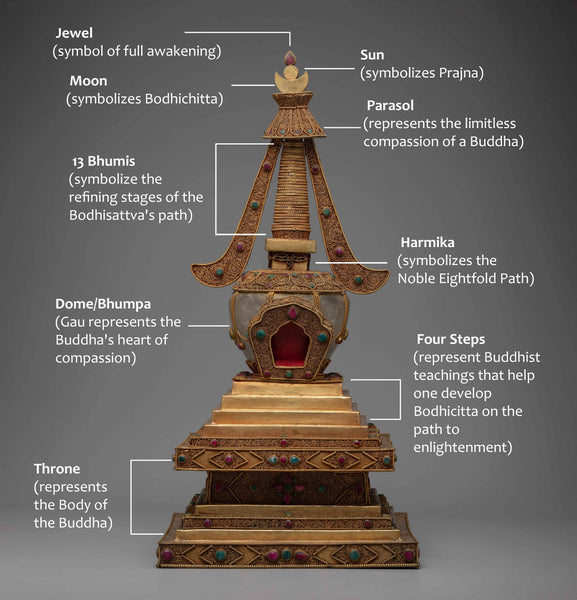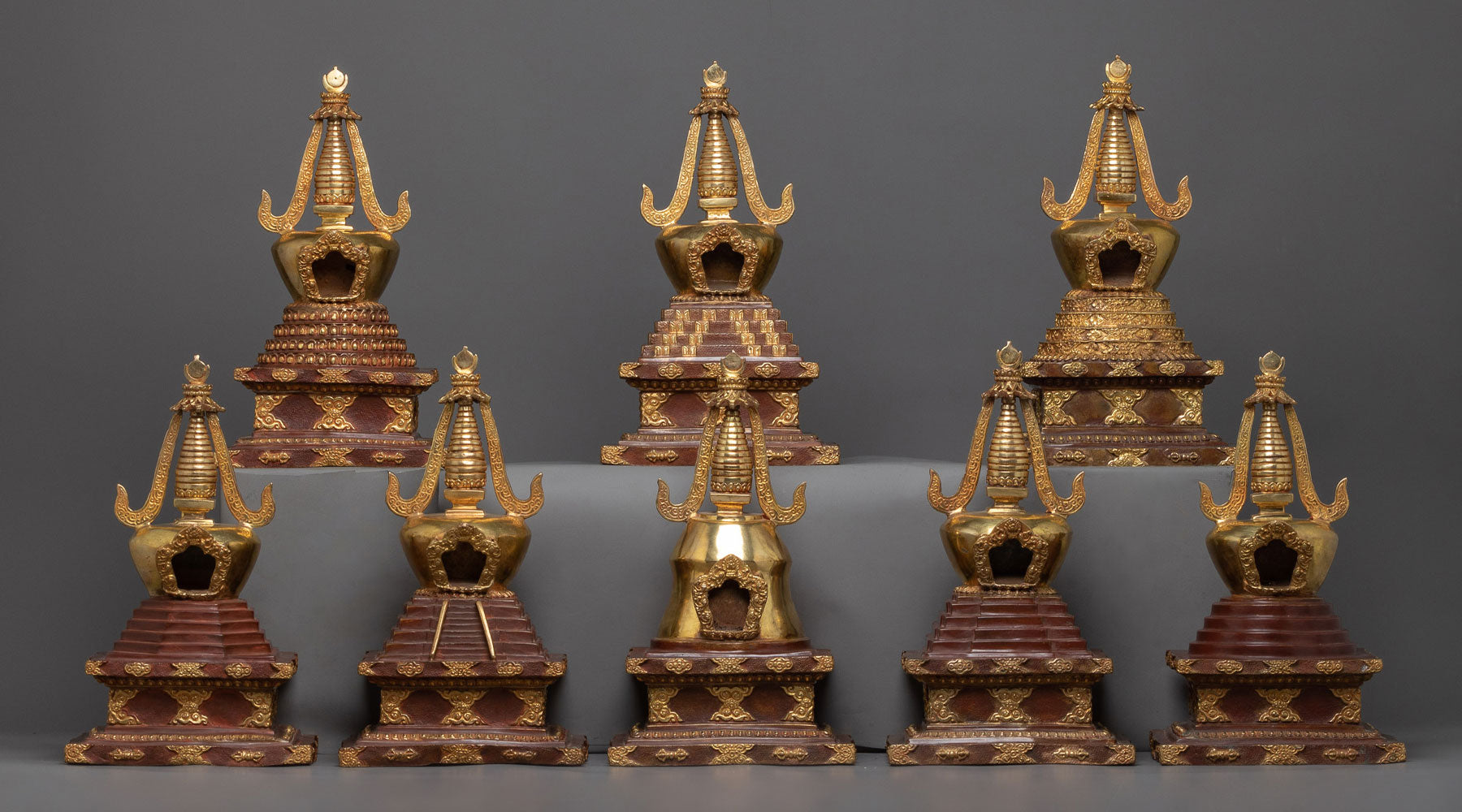A Spiritual Odyssey: Journeying Through the Great 8 Buddhist Stupas
Buddhism, a significant global religion, abounds with symbolism and sacred edifices. Among these, stupas stand out, bearing immense significance within Buddhist culture for embodying profound spiritual ideas. The Eight Great Stupas, revered monuments, encapsulate fundamental aspects of Buddhism. Each stupa holds a distinct meaning, playing a pivotal role in transmitting the wisdom of Buddha.
The Eight Great Stupas, also referred to as the Eight Great Caityas, serve as symbolic representations of critical events in the life of Buddha. Beyond their physical form, each stupa embodies a specific facet or moment in Buddha's spiritual journey, serving as poignant reminders of his teachings, wisdom, and the path to enlightenment for his followers.
Key Takeaways:
- The Eight Great Stupas represent eight significant milestones in Buddha's life.
- Each stupa features a unique architectural design and symbolism.
- These stupas are enduring reminders of Buddha's teachings and path to enlightenment.
The Stupa's Evolution
Initially, stupas served as modest burial mounds for the Buddha. However, they underwent a remarkable transformation, evolving into architectural wonders that expanded in scale and importance. These stupas eventually became central hubs for worship, meditation, and pilgrimage.
Symbolisms in Stupa

The stupa comprises distinct segments, each symbolizing various aspects of Buddhist teachings that underscore the path to enlightenment. Beginning with the foundational tier and ascending to the pinnacle, it presents a progressive journey, akin to an aspirational roadmap for spiritual development.
It is a powerful symbol in Buddhism, serving as a reminder to practitioners of their spiritual journey, the pursuit of enlightenment, and the enduring wisdom of Buddha. It functions as both a physical structure and a profound spiritual symbol that instills a sense of reverence and contemplation.
Click here to learn more about Types Of Symbolism in Stupa
List of the Eight Great Stupas

Click here to view The Eight Stupa Set
| Stupa | Events It Represents | Structure |
| Lotus Blossom Stupa |
Buddha's birth in Lumbini |
White dome with a lotus flower atop |
| Enlightenment Stupa |
Buddha's enlightenment under the Bodhi tree |
Gleaming white stupa with a gold pinnacle |
| Stupa of Many Doors |
Buddha's first sermon in Deer Park |
Intricately carved stupa with multiple entrances |
| Stupa of Descent |
Buddha's descent from Trāyastriṃśa Heaven |
Stupa with a descending path |
| Stupa of Great Miracles |
Buddha performing miracles |
Multi-story stupa with intricate carvings |
| Stupa of Reconciliation |
Buddha's reconciliation of the Sangha |
Octagonal stupa with inscriptions |
| Complete Victory Stupa |
Buddha's prolonged life at the request of devotees |
Stupa with intricate carvings and symbolism |
| Nirvana Stupa |
Buddha's entry into the final Nirvana |
Stupa with a reclining Buddha statue |
Lotus Blossom Stupa

The Lotus Blossom Stupa serves as a profound symbol of purity and enlightenment. It takes inspiration from the lotus flower, which thrives in murky waters yet emerges unspoiled and exquisite. This stupa encapsulates the voyage from ignorance to enlightenment, portraying the soul's transcendence beyond the material realm to attain spiritual purity.
Moreover, the Lotus Blossom Stupa stands as a testament to Siddhartha Gautama's initiation into his journey towards enlightenment, signifying his birth.
-
Lotus Symbolism
The lotus, a recurring symbol in Buddhism, represents purity and enlightenment. It is said that lotus flowers bloomed wherever the Buddha walked at his birth. -
Birth of Siddhartha
This stupa marks the birth of Siddhartha Gautama, who later became the Buddha. It symbolizes the start of his earthly existence and spiritual journey.
Enlightenment Stupa

The Enlightenment Stupa embodies the pivotal moment when Siddhartha Gautama, the future Buddha, achieved enlightenment beneath the Bodhi tree. This stupa serves as a constant reminder of the journey to enlightenment, which involves meditation, self-discovery, and the pursuit of wisdom.
The Enlightenment Stupa commemorates the most pivotal moment in the Buddha's life, marking his enlightenment beneath the Bodhi tree. Notable features of this stupa include:
-
Awakening to Truth
This stupa symbolizes the Buddha's realization of the truth of existence and the end of suffering. -
Bodhi Tree Significance
The Bodhi tree, where the Buddha meditated, holds deep significance as the sacred site of his enlightenment—a transformative milestone in the history of Buddhism.
Stupa of Many Doors

The Stupa of Many Doors is distinct for its abundance of entrances, signifying the diverse avenues one can pursue to achieve enlightenment. This stupa conveys the inclusive concept that there are numerous paths to spiritual awakening.
Furthermore, the Stupa of Many Doors represents the Buddha's embrace of all individuals, regardless of their backgrounds or beliefs. Notable features include:
-
Inclusive Buddhism
The multitude of entrances in this stupa symbolizes Buddhism's openness to diverse backgrounds and belief systems. -
Path to Enlightenment
This stupa underscores the inclusive essence of Buddhism, providing all individuals with the chance to embark on the journey toward enlightenment.
Stupa of Descent

The Stupa of Descent commemorates the Buddha's return from a celestial realm after imparting teachings to his mother. It underscores the profound connection between the spiritual and material realms and exemplifies the Buddha's compassion.
-
Compassion and Guidance
This stupa symbolizes the Buddha's compassionate nature and capacity to guide beings in earthly and heavenly realms. -
Connecting with the Divine
It signifies the profound connection between the earthly and celestial spheres through the teachings of the Buddha.
Stupa of Great Miracles

The Stupa of Great Miracles commemorates the extraordinary events in the Buddha's life, such as his ability to multiply himself and perform astounding feats, highlighting the supernatural aspects of Buddhism.
-
Miraculous Acts
This stupa is a marker of the instances when the Buddha performed extraordinary miracles to quell doubts and showcase his spiritual prowess. -
Faith and Devotion
It symbolizes the remarkable outcomes that can be realized through faith and unwavering belief in the Buddha's teachings.
Stupa of Reconciliation

The Stupa of Reconciliation symbolizes resolving conflicts and the significance of forgiveness, commemorating the Buddha's pivotal role in reconciling warring factions. This stupa is a poignant reminder of the transformative power of compassion and reconciliation.
-
Conflict Resolution
This stupa embodies the ideals of peace, harmony, and conflict resolution, as imparted through the teachings of the Buddha. -
Unity & Brotherhood
It emphasizes the essential values of unity and brotherhood among Buddhist monks.
Complete Victory Stupa

The Complete Victory Stupa symbolizes the Buddha's conquest over his inner demons and temptations during his meditation beneath the Bodhi tree, marking the triumph of internal fortitude and unwavering resolve over worldly distractions.
-
Triumph of Dharma
This stupa signifies the victory of Buddhism's teachings (Dharma) over competing philosophies and religions. -
Spread of Enlightenment
It underscores Buddhism's global reach and influence as it expanded across various regions.
Nirvana Stupa

The Nirvana Stupa signifies the Buddha's transition into Nirvana, the ultimate state of liberation from suffering and the cycle of rebirth, culminating in his spiritual journey and achieving ultimate peace.
-
Eternal Peace
This stupa symbolizes the Buddha's passage into Parinirvana, representing everlasting peace and liberation from the cycle of birth and death. -
Final Liberation
It embodies the central aspiration of Buddhism—to attain liberation from the cycle of suffering and rebirth.
Significance of the Eight Great Stupas
Stupas are more than just architectural structures. They embody the essence of Buddhist teachings. The Eight Great Stupas, in particular, offer deep insights into critical events of the Buddha's life, making them highly revered.
The Eight Great Stupas hold immense significance in Buddhism and provide valuable lessons and inspiration for practitioners. Here are the key takeaways from these stupas:
- Diverse Paths to Enlightenment: The Stupa of Many Doors imparts the idea that numerous routes exist to attain enlightenment, underlining the inclusivity and diversity within spiritual practice.
- Compassion and Reconciliation: The Stupa of Reconciliation serves as a potent reminder of the potency of compassion and forgiveness in conflict resolution and the sustenance of peace.
- Victory Over Temptations: The Complete Victory Stupa underscores the significance of inner strength and determination in conquering worldly distractions and enticements.
- Miracles and Supernatural Aspects: The Stupa of Great Miracles accentuates the extraordinary events in the Buddha's life, emphasizing the supernatural facets of Buddhism.
- Transcendence and Purity: The Lotus Blossom Stupa symbolizes the transition from ignorance to enlightenment, emphasizing the purity of the soul.
- Attainment of Enlightenment: The Enlightenment Stupa is a constant reminder of enlightenment, achieved through meditation, self-realization, and wisdom.
- Connection Between Worlds: The Stupa of Descent highlights the connection between the spiritual and material realms, embodying the Buddha's compassion.
- Ultimate Liberation: The Nirvana Stupa commemorates the Buddha's passage into Nirvana, signifying ultimate liberation from suffering and the cycle of rebirth.
From the Lotus Blossom Stupa, representing purity and transcendence, to the Nirvana Stupa, marking the Buddha's ultimate liberation, each stupa narrates a unique tale and imparts invaluable teachings.
Whether through inclusivity, reconciliation, or conquering temptations, these stupas present a range of paths to understanding while embodying Buddhism's core values.
As pilgrims and seekers continue to make their way to these sacred sites, the Eight Great Stupas remain steadfast as guiding beacons, illuminating the path for souls on their journey toward enlightenment, compassion, and inner serenity. They endure as everlasting symbols of Buddhism's timeless wisdom extending an invitation to all to embark on their own spiritual quests of self-discovery and personal growth.














